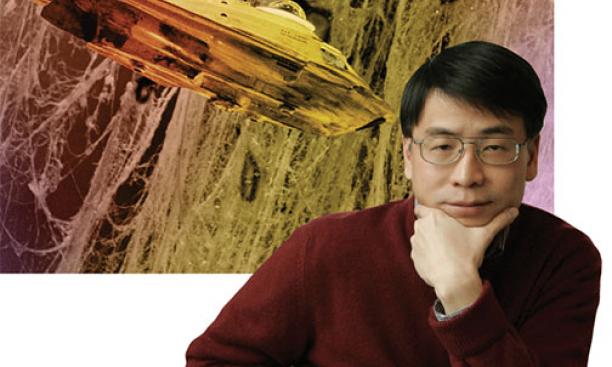

In the 1966 science-fiction film Fantastic Voyage, a team of scientists and their submarine are shrunk to half the size of a cell so they can slip into someone’s bloodstream. Today, chemistry professor Haw Yang is working to build a robot even smaller than that fictional submarine that can travel inside a cell.
Yang’s research taps into what may be the ultimate wish of many scientists: the ability to witness what goes on in a cell. Today, microscopes can see inside living cells, but they do not have the capability to follow a single molecule or an invading virus over a long period.
Yang’s goal is to build what he calls the NanoLab, a microscopic, swimming robot that can deliver cargo to a specific location in a cell and map out the cell’s interior topology. It could be introduced into a living cell and, much like the remote-controlled submarine, be guided by scientists to capture images and follow the activity of a single molecule or microbe. “Imagine if you could visually follow a virus as it approaches and is internalized into the cell,” says Kevin Welsher, a postdoctoral researcher in the Yang lab.
Understanding how a virus attaches to and penetrates a cell — a process scientists do not fully comprehend — could assist in the development of medications to treat HIV and other viral infections. And Yang’s NanoLab potentially could deliver a diagnostic tool or a drug to a specific location in a cell. While other scientists have built nano-scale sensors, what is potentially groundbreaking in Yang’s work is the prospect that the NanoLab could carry and steer an individual molecule in a cell without disturbing the cell’s inner workings. Dean for Research Pablo Debenedetti says that what Yang is pursuing “has not been attempted before. This research is very exciting.”
Yang has been working on the project for almost 10 years, but progress was slow because of the difficulty of securing funding. “This is not a well-defined field. We are doing something completely new,” Yang says. Last year, he was awarded $700,000 by Princeton’s Schmidt Fund, which provides funding for early-stage, high-risk work. Yang’s laboratory, which brings together researchers with backgrounds in physics, cell biology, and chemistry, now can work on each piece of the project simultaneously, speeding up progress.
Yang and his team already have demonstrated that the idea could become reality. The team has built a robotic “micro-swimmer” — smaller than a cell — that can be steered when suspended in a solution by using a laser. The lab now is working to make the micro-swimmer one-tenth its current size, so it can fit into a cell without interrupting cellular activity.
Yang hopes to enable the NanoLab to carry a single protein and watch how it functions. So far proteins, which do most of the work in a cell, have been studied only in test tubes. Says Yang, “We are convinced that this approach and vision will really change the way people approach science.”
